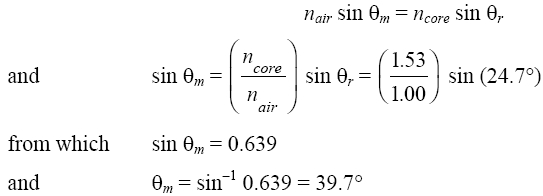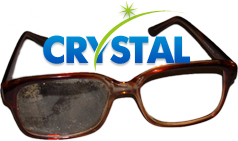
Let’s use this result and Snell’s law to determine the entrance cone for light rays incident on the face of a clad fiber if the light is to be trapped by total internal reflection at the core-cladding interface in the fiber.
Example 3
A step-index fiber 0.0025 inch in diameter has a core index of 1.53 and a cladding index of 1.39. See drawing. Such clad fibers are used frequently in applications involving communication, sensing, and imaging. 
What is the maximum acceptance angle Ɵm for a cone of light rays incident on the fiber face such that the refracted ray in the core of the fiber is incident on the cladding at the critical angle?
Solution: First find the critical angle Ɵc in the core, at the core-cladding interface. Then, from geometry, identify θr and use Snell’s law to find Ɵm.
(1) From Equation 3-3, at the core-cladding interface
(2)From right-triangle geometry, Ɵr = 90 − 65.3 = 24.7°
(3)From Snell’s law, at the fiber face, 
Thus, the maximum acceptance angle is 39.7° and the acceptance cone is twice that, or 2 θm = 79.4°. The acceptance cone indicates that any light ray incident on the fiber face within the acceptance angle will undergo total internal reflection at the core-cladding face and remain trapped in the fiber as it propagates along the fiber.
Page: 12345678910111213141516171819202122232425262728293031323334353637383940
| Eyes carePhysicianBate's booksTechnologyForumLaser corre.Blues under eyesburning in the eyesanother diseasesMedical mistery Naturally eyesight correction. No laser eye surgery. Restore eyesight. Vision correction. |




